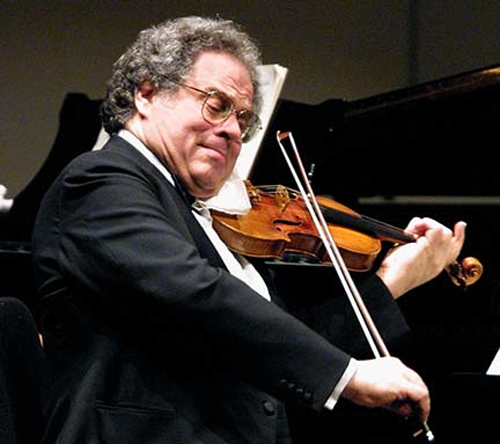With a shaky technique and fitful engagement, Perlman still packs them in at the Broward Center
The program distributed at the Broward Center states that Itzhak Perlman is “undeniably the reigning virtuoso of the violin,” a claim that is surely no longer true. If he held the throne in the 1970s and 80s, he no longer holds it today.
But he still packs in crowds like no other violinist, and despite a decayed technique and an often half-hearted approach to the music, Perlman received a series of standing ovations Monday in Fort Lauderdale for his performances of sonatas and showpieces. As has long been the case with Perlman, the light works–whether melodic or bravura–came off best.
In Mozart’s Sonata in B-flat Major, K. 454, which opened the program, he showed that his intonation and bowing have become shaky, and he slid from note to note in a manner that seemed out of place in this light 18th-century work.
Paradoxically, the ensuing Sonata No. 7 in C Minor by Beethoven felt miniaturized and seemed like a small-scale work in his hands, with little scope or drama. Only in the Adagio, a singing melody that allowed him to unleash his lyric side, did Perlman play in a manner reminiscent of his peak years.
The last movement lacked any sense of drive, even with plenty of scratchy bow noise. The romantic drama of Saint-Saëns’ Sonata No. 1 in D Minor appeared to engage him more, and the perpetual motion finale was a rapid-fire ride, albeit with a lot of missed notes.
Perlman, who turned 65 last year, undeniably no longer sounds like the musician whose technical mastery and warm, committed musicianship really did make him the greatest violinist of his generation. It is not simply a matter of technique. Those fortunate enough to hear the great virtuoso Nathan Milstein in his early 80s heard a violinist whose bowing and fingering weren’t what they used to be but whose musical personality was so strong he brought real style and grandeur to his playing. But Monday in Fort Lauderdale Perlman seemed disengaged, either unable or unwilling to put much energy into his music-making.
In the last part of the program, a series of short pieces announced from the stage, Perlman was more at home, discussing the works with relaxed humor and playing them with a more assured style and greater commitment than he had shown in the sonatas.
Fritz Kreisler’s transcription of a Schumann work for oboe and piano was an ingratiating, sweetly rendered melody, with a sense of urgency and spontaneity that had been lacking in earlier works. Kreisler’s Variations on a Theme by Corelli opened with a four-square theme played with great dignity and went into a series of difficult variations, fast, complex music rendered with crisp, accurate bowing and a natural shape to the phrases.
Perlman ended the program with a transcription for violin and piano of a caprice for two violins by the 19th-century Polish virtuoso Henryk Wieniawski, an extremely rapid exercise in triplets, where Perlman’s accuracy lapsed but he kept up the tempo.
Perlman was ably accompanied by his usual pianist, Rohan De Silva. If De Silva performed with the manner of a man playing tennis with his boss, he still brought an immaculate technique and a lively style to his playing.
As an encore, Perlman played the Italian virtuoso Antonio Bazzini’s Dance of the Goblins, a showpiece almost comical in its difficulties. He tossed off the blazing runs, tenths, left-hand pizzicato and bouncing bow passages with devilish abandon, despite a rapid tempo that maximized the technical hurdles. Considering the lackluster playing earlier, this technically demanding music surprisingly received the best performance of the evening.
Itzhak Perlman performs Tuesday at 8 p.m. at the Kravis Center for the Performing Arts in West Palm Beach. www.kravis.org; 800-572-8471.
Posted in Performances
2 Responses to “With a shaky technique and fitful engagement, Perlman still packs them in at the Broward Center”
Leave a Comment
Tue Mar 1, 2011
at 10:32 am
2 Comments








Posted Mar 01, 2011 at 1:05 pm by susan
Well, I’m no critic. Whether or not your review is on point, I cannot say. However, the standing ovations were more than merited for this performer who has given so much to the world of music – both through his playing and his music camp for budding musicians. And yes, despite his diminishing frame, he remains as large as ever. Moreover, whatever technical difficulties he might have had are most likely caused by the return of his polio.
Perhaps his enthusiasm was a bit dampened by an audience who, regardless of the price of their tickets, continued to clap at the end of a movement rather than the end of a piece.
Posted Mar 02, 2011 at 8:48 pm by Pedro Sandler
I never heard him play live (I lived almost all my life abroad); I thought that I was confused when I heard some mistakes as he played Mozart and Beethoven.
But the second part, first Camille Saint Saint-Saens and then the short pieces were amazing.
I didn’t like the acoustic of the Theater (I sat at the upper part) and very important I don’t understand the lack of knowledge that some of the public had regarding the clapping at the end of each movement; any classical musician is concentrated in the music and needs a valuable partner (public) and in this case it didn’t happen.
South Florida needs more classical music education